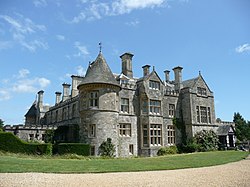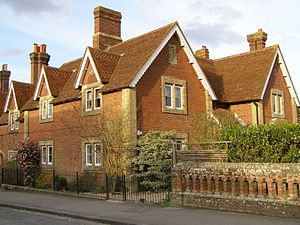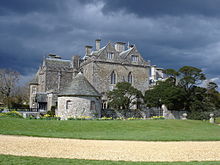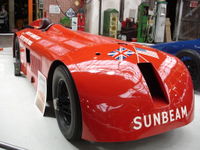Beaulieu
| Beaulieu | |
| Hampshire | |
|---|---|
 Beaulieu Palace House | |
| Location | |
| Grid reference: | SU385025 |
| Location: | 50°49’12"N, 1°27’-0"W |
| Data | |
| Population: | 829 (2001) |
| Post town: | Brockenhurst |
| Postcode: | SO42 |
| Dialling code: | 01590 |
| Local Government | |
| Council: | New Forest |
| Parliamentary constituency: |
New Forest East |
Beaulieu (bjuːli) is a small village on the south eastern edge of the New Forest in Hampshire. It is home to both Beaulieu Palace House and the British National Motor Museum.
History
The picturesque hamlet of Bucklers Hard, with its Georgian cottages running down to the Beaulieu river is part of the 9,000 acre Beaulieu Estate. It was the "birthplace" of many British naval vessels, including many of Admiral Nelson's fleet, as the shipyards used timber felled in the New Forest and brought to the sea and the shipyards here.
The industry of timber shipbuilding declined in the 19th-century and today the hamlet is given over to tourism, with a small maritime museum, and a modern yachting marina. Bucklers Hard was where Sir Francis Chichester began and finished his single-handed voyage around the world in Gipsy Moth IV.

Beaulieu village has remained largely unspoilt by progress, and is a favourite tourist stop for visitors to the New Forest, and also for birders seeking local specialities like Dartford warbler, honey buzzard and hobby.
Beaulieu Castle was featured in the 2005 comedy-drama film Mrs Palfrey at the Claremont starring Joan Plowright and Rupert Friend.
Beaulieu Jazz Festival
In the late 1950s Beaulieu was the surprising location for one of Britain's first experiments in pop festival culture, with the annual Beaulieu Jazz Festival, which quickly expanded to become a significant event in the burgeoning jazz and youth pop music scene of the period.
Camping overnight, a rural invasion, eccentric dress, wild music and sometimes wilder behaviour — these now familiar features of pop festival happened at Beaulieu each summer, culminating in the so-called 'Battle of Beaulieu' at the 1960 festival, when rival gangs of modern and traditional jazz fans indulged in a spot of what sociologists went on to call 'subcultural contestation'.[1]
Transport
The nearest railway station is Beaulieu Road, about 4 miles away on the London-Weymouth main line. However, this station has an infrequent service (3 trains a day typically), and there are more frequent services at the next station to the east, Ashurst, 10 miles from Beaulieu, and the next to the west, Brockenhurst, 6 miles away.
Palace House

Palace House overlooks the village from across Beaulieu River. It was founded in 1204 as the gatehouse to Beaulieu Abbey, and has been the ancestral home of a branch of the Montagu family since 1538, when it was bought from the crown following the Dissolution of the Monasteries by Henry VIII.
The house was extended in the 16th century, and again in the 19th century, and is today a fine example of a Gothic country house.
Although still home to the current Lord and Lady Montagu, parts of the house and gardens are open daily to the public. It is a member of the Treasure Houses of England consortium.
British National Motor Museum

The village is also home to the British National Motor Museum.
The museum was opened in 1952 as the Montagu Motor Museum and became a charitable trust in 1972. It contains an important collection of historic motor vehicles, including four world land speed record holders:
- Sir Malcolm Campbell's 1924 Blue-Bird and
- His son Donald Campbell's 1964 Bluebird CN7,
- The 1927 Sunbeam 1000HP (the first motor car to reach 200 miles per hour)
- The 1929 Irving-Napier Special 'Golden Arrow'.
The last two were both driven by Major Henry Segrave.
Outside links
| ("Wikimedia Commons" has material about Beaulieu) |
- Beaulieu Palace House webpage
- Photographs and Information from Strolling Guides
- New Forest Community Media - A not-for-profit media site serving the National Park
References
- ↑ McKay 2004, 2005
Books
- Lord Montagu of Beaulieu (2000) Wheels Within Wheels: An Unconventional Life. London: Weidenfeld and Nicolson.
- George McKay (2004) '"Unsafe things like youth and jazz": Beaulieu Jazz Festivals (1956–61) and the origins of pop festival culture in Britain'. In Andy Bennett, ed. Remembering Woodstock (Aldershot: Ashgate).
- George McKay (2005) Circular Breathing: The Cultural Politics of Jazz in Britain, chapter one 'New Orleans jazz, protest (Aldermaston) and carnival (Beaulieu [Jazz Festival 1956-61])'. Durham NC: Duke University Press.
